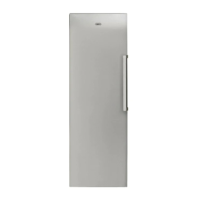Page 13
Protection of plastic surfaces
Do not place l
iquid oils or oil-cooked meals in
your refrigerator in unsealed containers as
they may damage the plastic surfaces. In
case of spilling or smearing oil on the plastic
surfaces, clean and rinse the relevant part of
the surface at once with warm water.
Maintenance and Cleaning
x Always disconnect the plug from the
mains socket before cleaning.
x Note
that turning the therm
ostat to ‘0’ does
not switch the power off to the refrigerator.
x Clean the inside of the refrigerator when
necessary by using a solution of one table
spoon of Bicarbonate of Soda to two litres
of warm water.
x Dry with a soft cloth.
x Do not use pot scorers or abrasive
p
owders to clean the refrigerator.
x Spillages, especially citric and acidic
juices, must be wiped up immediately as
they could stain the interior of the
refrigerator.
x Shelves may be removed for cleaning
purposes.
x The back of the refrigerator may be
vacuumed or dusted using a soft bristle
brush.
x Make sure that no water
enters the lamp
housing and other electrical items.
x If your
refrigerator is not going to be used
for a long period of time, unplug the power
cable, remove all food, clean it and leave
the door ajar.
x Check door seals regularly to ensure they
are clean and free from food particles.
5
Warning: Repairs must be
carried out by authorised persons
only. Repairs carried out by
incompetent persons create a
user risk.
Unplug the refrigerator from the
wall socket when you clean the
refrigerator.
The internal light is a LED type. To replace
the lamp, please contact a qualified
technician.
Replacing the light

